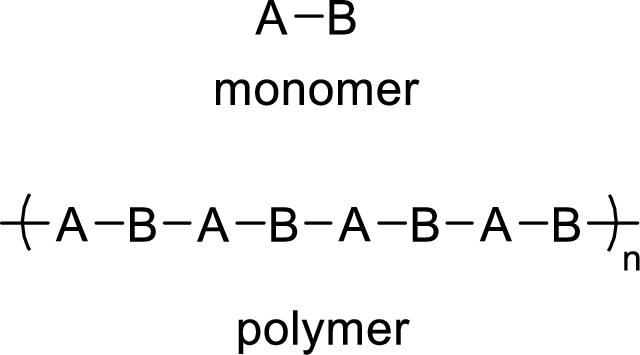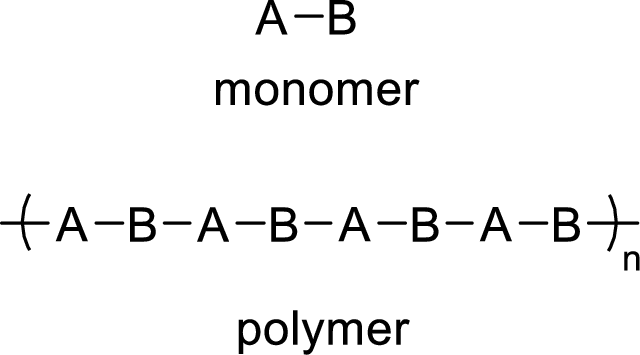
(a)
Interpretation:
The abbreviated structure for the poly (vinyl chloride) has to be drawn by putting brackets around the repeating monomer unit.
Concept Introduction:

Addition polymers are formed when the monomers units are added to one another to form the polymer. In addition reactions, no fragments are lost from the molecule.
(b)
Interpretation:
The abbreviated structure for the polypropylene has to be drawn by putting brackets around the repeating monomer unit.
Concept Introduction:
Polymers are made up of many number of small repeating units called monomers. Monomer is a small unit which reacts with similar units to form a polymer.

Addition reaction polymers:
Addition polymers are formed when the monomers units are added to one another to form the polymer. In addition reactions, no fragments are lost from the molecule.
Want to see the full answer?
Check out a sample textbook solution
Chapter 15 Solutions
CHEM 212:CHEMISTSRY V 2
- Heparin is used as an anti-coagulant. A risk of heparin use is thrombocytopenia, or low platelet count. This risk is minimized with the use of low molecular weight heparins (LMWH), therefore it is desirable to separate LMWH from higher molecular weight heparins. The method of choice to do this is molecular exclusion chromatography. Below is a chromatogram from a molecular exclusion chromatographic run. Peaks ranging from A to J are clearly distinguishable. The heparin mixture that was analyzed had anywhere from 6 to 30 repeat units of monomer (where the heparin with 30 repeat units would be roughly five times the size of the heparin with six repeat units). a. Which letter most likely represents the peak with 6 repeat units given these heparin polymers were separated with molecular exclusion chromatography? b. Explain your reasoning describing the mechanism of retention in molecular exclusion chromatography. 100 80 60 60 Relative Abundance 40 40 E GH 20 20 B A 36 38 40 42 44 46 48 50 50…arrow_forwardHELP NOW PLEASE ! URGENT!arrow_forwardHELP NOW PLEASE ! URGENT!arrow_forward
- Draw a Newman projection for the molecule below from the perspective indicated. Which of the groups (letters A-H) are methyl groups? CH3 H H H A H B ☑ >> H. ABCDEFG I H -H CH3 G D CH F E Numeric 4 points How many gauche interactions exist in the conformation shown in the previous problem? 1arrow_forwardHELP NOW PLEASE ! ASAP! URGENT!arrow_forwardHELP NOW PLEASE ! ASAP! URGENT!arrow_forward
- Would the following organic synthesis occur in one step? Add any missing products, required catalysts, inorganic reagents, and other important conditions. Please include a detailed explanation and drawings showing how the reaction may occur in one step.arrow_forwardPls help.arrow_forward13) When solid barium phosphate is in equilibrium with its ions, the ratio of barium ions to phosphate ions would be: a. 1:1 b. 2:3 c. 3:2 d. 2:1 14) The pH of a 0.05 M solution of HCl(aq) at 25°C is 15) The pH of a 0.20 M solution of KOH at 25°C isarrow_forward
 ChemistryChemistryISBN:9781305957404Author:Steven S. Zumdahl, Susan A. Zumdahl, Donald J. DeCostePublisher:Cengage Learning
ChemistryChemistryISBN:9781305957404Author:Steven S. Zumdahl, Susan A. Zumdahl, Donald J. DeCostePublisher:Cengage Learning ChemistryChemistryISBN:9781259911156Author:Raymond Chang Dr., Jason Overby ProfessorPublisher:McGraw-Hill Education
ChemistryChemistryISBN:9781259911156Author:Raymond Chang Dr., Jason Overby ProfessorPublisher:McGraw-Hill Education Principles of Instrumental AnalysisChemistryISBN:9781305577213Author:Douglas A. Skoog, F. James Holler, Stanley R. CrouchPublisher:Cengage Learning
Principles of Instrumental AnalysisChemistryISBN:9781305577213Author:Douglas A. Skoog, F. James Holler, Stanley R. CrouchPublisher:Cengage Learning Organic ChemistryChemistryISBN:9780078021558Author:Janice Gorzynski Smith Dr.Publisher:McGraw-Hill Education
Organic ChemistryChemistryISBN:9780078021558Author:Janice Gorzynski Smith Dr.Publisher:McGraw-Hill Education Chemistry: Principles and ReactionsChemistryISBN:9781305079373Author:William L. Masterton, Cecile N. HurleyPublisher:Cengage Learning
Chemistry: Principles and ReactionsChemistryISBN:9781305079373Author:William L. Masterton, Cecile N. HurleyPublisher:Cengage Learning Elementary Principles of Chemical Processes, Bind...ChemistryISBN:9781118431221Author:Richard M. Felder, Ronald W. Rousseau, Lisa G. BullardPublisher:WILEY
Elementary Principles of Chemical Processes, Bind...ChemistryISBN:9781118431221Author:Richard M. Felder, Ronald W. Rousseau, Lisa G. BullardPublisher:WILEY





